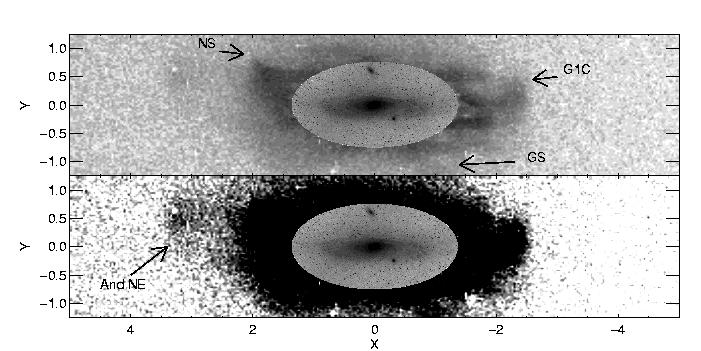I. SDSS
data: M31
(SDSS projects in collaboration with
Grebel, E.K., Zucker, D.B., Bell, E.F., Rix, H.-W., Holtzman, J., D.
Martinez-Delgado)
We developed a method to identify
planetary nebula (PN) candidates in imaging data of the Sloan Digital
Sky Survey (SDSS). This method exploits the SDSS' five-band sampling of
emission lines in PN spectra, which results in a color signature
distinct from that of other sources and can be applied to galaxies where
PNe appear as point sources. We tested this method with SDSS data of
M31. In areas searched by previous authors, we were able to recover
about 6/7 of the earlier known PNe. We are continuing our work on M31,
and are in the process of extending it to other nearby galaxies to the
extent possible. The ultimate goals of this work are to use PNe as
tracers of kinematics in large galaxies where they are sufficiently
numerous (e.g., in M31) and of chemical evolution (feasible even in
low-mass galaxies where only 1-2 PNe are detected).

|
M31 Stellar Substructure in the SDSS Data:
The spatial distribution of all stars with 21 < i < 22, with an
inset optical image of M31 to scale. The arrows indicate major halo
substructures: the northern spur (NS), the giant stream (GS) and the G1 clump (G1C). Anromeda NE's center is
located at about (3,0.5) (From Zucker,
D.B., Kniazev, A.Y. et al., New Giant Stellar Structure Near the Outer
Halo of M31: Satellite or Stream?,
2004, ApJ, 612, 117L).
|

|
The spatial distribution of all selected
PNe candidates from M31 SDSS data. The figure coordinates are the same as for
Figure above. X and Y are in arcdegrees from the center of M31, along
the major and minor axes, respectively. With blue triangles all stellar
PNe candidates of the first priority are shown. With red filled circles
all stellar PNe candidates of the first priority that were identified
from the earliest works are shown. With pink triangles all stellar PNe
candidates of the second priority are shown. With yellow diamonds all
extended PNe candidates of the second priority are shown. With green
diamonds all extended PNe candidates of the first priority are shown.
|
Last News
(14.10.2004):
For follow up spectroscopy of selected PNe candidates from M31 SDSS
data we had requested and had got 4+4 nights of Service Mode Rank A
observations with CAFOS instrument is installed at the 2.2m telescope at
Calar Allto Observatory (Spain). After 8 nights of observations with
poor weather (average seeing from 2.0 to 2.5 arcsec) 86 candidates were
observed: 9 are well-known PNe to calibrate our data, 52 of stellar PNe
candidates of the first priority, 14 of stellar PNe candidates of the
second priority, and 17 of extended candidates of the first and the
second priority that were located at the largest distances from the
center of M31. The observations have finished.
We
have currently the next results:
- 86 of our candidates were observed in total;
- 77 of them are really new candidates (not from
well-known list);
- 45 of stellar PNe candidates of the first
priority from 52 newly observed candidates are real PNe and our
selection rate for such kind of objects is 87%
- 11 of stellar PNe candidates of the second
priority from 11 newly observed candidates are real PNe and our
selection rate for such kind of objects is 79%
- 5 of extended PNe candidates of the first
priority from 8 newly observed candidates are real PNe and our selection
rate for such kind of objects is 63%
- Our method of PNe
selection from SDSS-data really works!
- We have found two PNe in the area of Andromeda
NE!
- These PNe are located at the projected
distances ~48 Kpc and ~41 Kpc from the center of M31.
- We have also found one more distant PN at the
SW part of M31 with projected distance ~37.5 Kpc from the center.
|

|
| Figure: The spatial distribution of observed PNe
candidates from SDSS M31 data. The figure coordinated are the same as
for Figures above.š The black ellipse indicates the extend and
inclination of M31's disc, and the location of NGC205, M32 and Andromeda
NE are also marked with big black circles. The blue ellipse indicates
the area of location of PNe from the disc of M31 that were found with
Planetary Nebula Spectrograph (was calculated from Figure 1 of Merrett
et al., MNRAS, 2003,346,L62). With small circles all our stellar PNe
candidates of the first priority are shown. With filled small circles
all known PNe from the our sample are shown (all of them are from the
first priority candidates). With black crosses all stellar PNe
candidates of the second priority are shown. With triangles and squares
all extended PNe candidates of the first and the second priority are
shown. PNe candidates that after observations appeared as real PNe are
shown with red crosses. PNe candidates that after observations did not
appeared as any emission-line objects are shown with blue crosses. PNe
candidates that after observations appeared as emission-line galaxies
are shown with green crosses (PS-version of this
Figure). |
II. Spectroscopy of
PNe in Local Group Galaxies:
(In collaboration with Grebel, E.K.,
Pustilnik, S.A., Pramsky, A.G.)
We present the first results of NTT
spectroscopy of HII regions and PNe in three dwarf galaxies in the
nearby Antlia-Sextans poor group of galaxies: Sextans A, Sextans B and
NGC 3109. For the most PNe and HII regions in these galaxies O,N,Ne,S,Ar
and He abundances have been obtained with the classic Te-method after
the detection of the [OIII] 4364 A line.
|